Since 2020, facility owners, operators and service providers—as well as CAFM Software vendors—have faced many new challenges. Throughout, Comparesoft has worked closely with its partners and continued to match Facility Management Software buyers with solutions tailored to their needs.
As a result of our ongoing collaborations, we have analysed:
- Buyer requirements
- Buyer industries and roles
- Facility management market trends and opportunities
Here’s a summary of what we’ve found:
CAFM User Requirements
- Buyers are, on average, owners/operators managing over 20 sites and multiple facility types. They coordinate under 500 jobs per month, require access for multiple user groups, desire a feature set that excels at core CAFM operations, and are seeking a solution that can be implemented in one to three months.
CAFM User Industries and Roles
- Most buyers are, predictably, involved with buildings, facilities, real estate and housing, with a diverse presence from other industries that includes education, healthcare, hospitality and charities.
- Similarly, the most popular title was “Facilities Manager”, with “Director” and “Head of Facilities/Properties/Estates” occurring often. Managers from core facilities-related disciplines were well represented, as were variants of “Director” and “Head of “.
- The majority of CAFM solution buyers occupied mid-tier or management roles, with 89% overall coming from mid-tier/management or senior/executive/leadership roles.
CAFM Market Trends
- We see two significant trends in the CAFM market. First is the rise of “next-gen” organisations; organisations that emphasise principle-driven, autonomous decision-making and remote-first, hybrid working within distributed teams. Second, is the continued presence of spreadsheets in the workflows of individuals.
CAFM Gaps in the Market
- The opportunity we see in the CAFM market hinges on a fundamental change in perspective. It is a shift from optimising facility health and wealth as an objective in and of itself, to optimising facility health and wealth to serve people.
The summaries above are derived from on-platform data analysis, off-platform research and investigation, Comparesoft’s understanding of CAFM Software, close partnerships with our vendors, and interactions with buyers. Read on to explore each of the four summaries in-depth.
FREE DOWNLOAD: CAFM Market Report and Insights Infographic
Find the Best Facilities Management Software For Your Market
What Type of Facilities Do You Manage?
User Requirements
Summary: CAFM Software buyers are, on average, owners/operators managing over 20 sites and multiple facility types. They coordinate under 500 jobs per month, require access for multiple user groups, desire a feature set that excels at core CAFM operations, and are seeking a solution that can be implemented in one to three months.
Facility Types
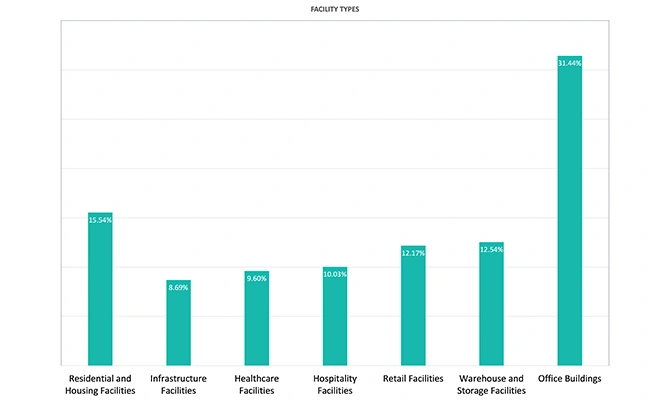
- On average, users selected at least two facility types
- The most popular facility type by far was offices (~62%), with educational facilities and industrial plants also cited often (~42% respectively)
- Close behind these were residential and housing facilities (~31%), warehouse and storage facilities (~25%), and retail facilities (~24%)
Facility Relationships
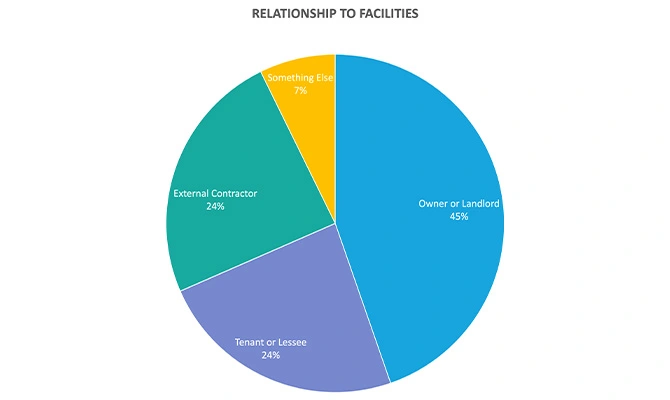
- The majority of users identified as owners or landlords (~61%)
- Users that weren’t owners or landlords identified themselves in near-equal proportions as either tenants or lessees (~32%) or external contractors (~~33%)
- A minority (~10%) of users cited their relationships with their facilities as something other than owners/landlords, tenants/lessees or external contractors
Site Volume

- It was most common for users to manage or be involved with over 20 sites (~34%)
- There was also a significant presence from users managing or involved with between two and five sites (~24%)
- It was least common for users to manage between 10 and 20 sites (~10%)
- Users managing a single site and between six and ten sites were similar in frequency (~16% and ~15% respectively)
- The most common scenario for users was the management of or involvement with more than one site (~84%)
Work Order Volume

- The majority of users (~80%) manage under 500 work orders per month
- A minority of users (~19%) manage more than 500 work orders per month
- The most cited monthly work order volume was up to 100 (~29%), with volumes of up to 50 WOs (~27%) and up to 500 WOs (~25%) close behind
Desired Features
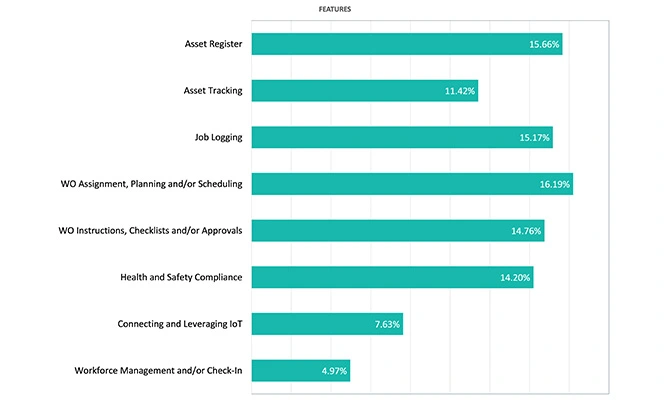
- Users required, on average, at least five CAFM features
- The most popular cited features were work order assignment, planning and scheduling (~85%) and an asset register (~82%)
- Five features—an asset register, job logging, work order assignment, planning and scheduling, work order instructions, checklists and approvals, and health and safety compliance—were selected by over 70% of users
- Spare parts visibility and purchasing were requested by ~63% of users
- The least popular features were space management (~21%), workforce management (~26%) and connecting and leveraging the Internet of Things (IoT) (~38%)
- 50% of users required a feature set that included core asset management functions, such as an asset register, asset tracking and job logging
- 54% of users required a feature set that include core facilities management features, such as job logging, working order assignment and planning, work instructions and approvals, and health and safety compliance management
System Users

- On average, users indicated that at least one stakeholder group would be using the CAFM system
- The majority (~47%) required access for all user groups—normal users, administrative users, technicians and back-office teams
- The most popular user type cited was administrative users (~36%)
- Non-admin/normal users and back-office team members were selected in near-equal proportions (~27% and ~28% respectively)
- The least popular requested user type was field technicians (~18%)
Implementation Timescale
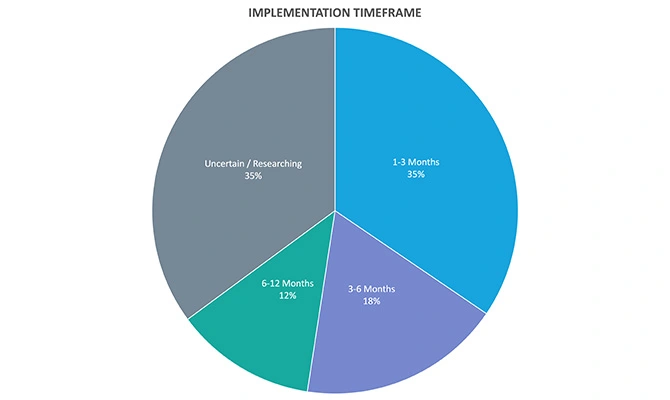
- ~35% of users were looking for a solution that could be implemented in one to three months
- 18% of users were seeking to implement a solution in three to six months, and ~12% were looking to implement a solution in six to twelve months
- The majority of users, however (~35%), were uncertain of their implementation timescale or were just researching
- Overall, ~70% of users either wanted to implement a solution in one to three months or were unclear about their implementation timescale
*Please note: the analyses in items one, two, five, six and eight are based on additional data analysis beyond the included graphic
User Industries and Roles
Summary: Most CAFM Software buyers are, predictably, involved with buildings, facilities, real estate and housing, with a diverse presence from other industries that includes education, healthcare, hospitality and charities.
Similarly, the most popular title was “Facilities Manager”, with “Director” and “Head of Facilities/Properties/Estates” occurring often. Managers from core facilities-related disciplines were well represented, as were variants of “Director” and “Head of “.
Finally, the majority of CAFM solution buyers occupied mid-tier or management roles, with 89% overall coming from mid-tier/management or senior/executive/leadership roles.
Industry Distribution
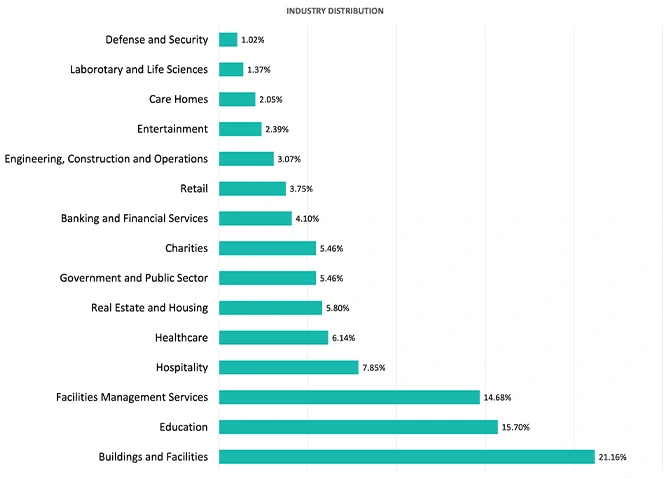
- The most cited industry was buildings and facilities (~18%)
- Education (~13%) and FM services (~12%) were the second and third most cited
- 35% of users cited an industry directly related to facility management (buildings and facilities, FM services or real estate and housing)
- Other popular industries included hospitality (~6%), healthcare (~5%), charities (~5%), and government and public sector (~5%)
- Only three selected industries—buildings and facilities, education, and FM services—were selected more than 10% of the time
- Users cited a wide array of industries beyond the ones mentioned above. Other notable inclusions were banking and finance (~4%), retail (~3%), and engineering, construction and operations (~3%)
Role Distribution
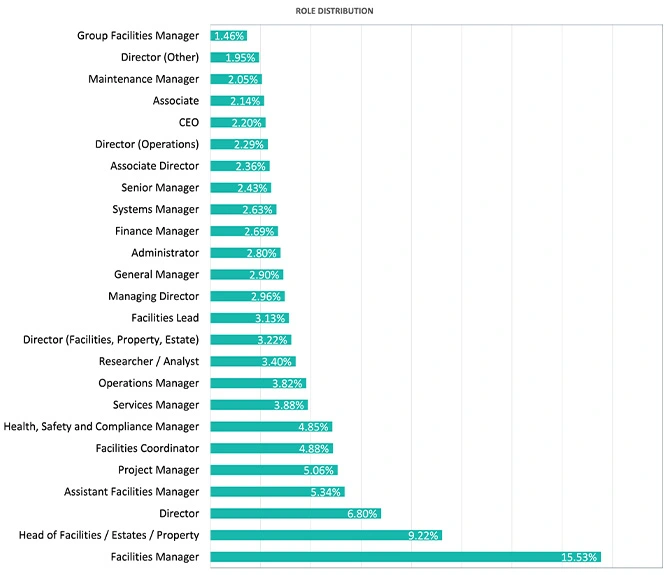
- “Facilities Manager” was the most cited title (~12%)
- “Head of Facilities/Property/Estates” (~7%) and “Director” (~5%) were also common
- Managers from core facilities-related disciplines—including projects, services, operations, and health, safety and compliance—were the most common group, appearing ~32% of the time
- Variants of “Director” were another common group, appearing ~16% of the time, as were “Head of ___” from diverse domains and departments, which appeared in ~11% of cases
Seniority Distribution
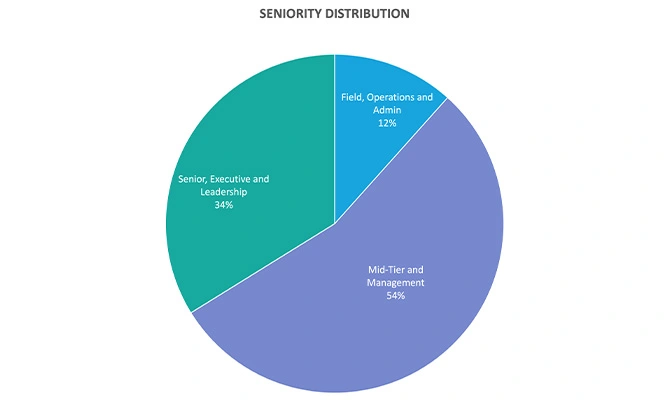
- 55% of users occupied mid-tier or management roles
- 34% of users occupied senior, executive or leadership roles
- 11% of users came from field, operations or administrative roles
- Overall, ~89% of CAFM buyers came from either mid-tier/management or senior/executive/leadership roles
CAFM Market Trends
Here at Comparesoft, we have identified two trends that will impact organisations involved in facility management. The first is the continuation of the transition to remote-first, highly autonomous teams. The second is the stickiness of the simple spreadsheet.
The Rise of “Next-Generation” FM Organisations
A detailed research program conducted by Simon Wardley reveals what separates a “traditional” organisation from a “next-generation” organisation. The linked report lays out the differences between the two organisation types across different categories, from sustainability to structure. But all the differences listed are based on a more fundamental divide:
- “Next-gen” organisations emphasise principle-driven, autonomous decision-making and remote-first, hybrid working within distributed teams
- “Traditional” organisations constrain themselves to office-first, procedure-driven approaches managed via centralised structures, locations and expertise
This is a critical difference for facility owners, operators and service providers. Let’s examine it through the lens of a common workflow: the logging, management and resolution of an issue. Below, we’ll walk through each step and highlight how a “traditional” organisation may approach it and how a “next-gen” organisation may approach it.
1. A User Logs an Urgent Issue
- “Traditional” approach: The user contacts a facility operator’s support team via phone or email and provides a brief description of the issue. They are thanked for raising the issue.
- “Next-gen” approach: The user accesses a dedicated self-service portal and provides a brief description of the issue. Along the way, they provide an uploaded photo, a priority estimate, and a categorisation (e.g. electrical). The user receives an auto-generated email containing their provided information and a link they can use to monitor the ticket and provide feedback as the issue progresses.
2. The Issue Is Triaged By the Facility Owner/Operator
- “Traditional” approach: An administrator examines the logged issue and creates a ticket within their CAFM system. Details, such as exact location, are chased if not present. Criteria like priority and issue type are allocated by the administrator.
- “Next-gen” approach: The issue is automatically triaged using information captured during the self-service issue logging process. An administrator conducts a quick review and approves the issue for action.
3. The Issue Is Assigned to an External FM Service Provider
- “Traditional” approach: Once the administrator has finished expanding the detail associated with an issue, they select an appropriate service provider and share the job details via email.
- “Next-gen” approach: Once an administrator has reviewed and approved the issues, it is automatically assigned to the next available engineer that matches the job’s required profile. The engineer is now able to access all information associated with the issue.
4. Preparation Is Undertaken, a Visit Is Scheduled, and an Engineer Is Dispatched
- “Traditional” approach: The service provider informs the facility operator that an engineer has reviewed the issue and that a visit has been scheduled. The engineer sets off on the scheduled day and time.
- “Next-gen” approach: The engineer uses the issue information—as well as access to similar historical issues—to optimise their loadout for a first-time fix. The engineer schedules the visit and the facility user receives an automatic update via email.
5. The Engineer Arrives, Investigates and Encounters a Deeper Issue
- “Traditional” approach: The engineer arrives on site, begins the investigation and discovers that the issue is more complicated than expected. Lacking the necessary materials and approval for an unexpected increase in cost, and with another scheduled job to attend, the engineer implements a temporary workaround and departs.
- “Next-gen” approach: The facility user receives a notification when the engineer departs on the day and arrives. The engineer discovers that the issue is more complicated than expected. However, the engineer has a selection of less common, more expensive materials to hand which are suitable. The engineer examines their available budget and looks at the recent SLA performance for this particular facility.
6. The Issue Is Resolved and Closed
- “Traditional” approach: The engineer returns several days later with the necessary materials and an approved increase in budget for the issue. They fix the issue and depart. Later, the service provider informs the facility operator that the issue is closed and provides an invoice for their service.
- “Next-gen” approach: The engineer prolongs the length of their visit and adjusts their daily agenda. Other clients receive an automatic notification of the delay. The engineer uses the additional materials to fix the issue. Whilst on site, they log evidence of their work and issue completion, review and send an auto-generated invoice, and complete a customer satisfaction survey. The original issue logger, the facility operator, and the service provider themselves all receive automated updates.
As the example shows, “next-generation” organisations provide autonomy to their teams, support personnel, and management staff. They give individuals, teams, and departments options and encourage them to make informed, contextualised choices in the moment and in direct consultation with end users. They involve more parties in reporting, analysis, and decision-making, instead of demanding conformance to opaque commands.
How does this occur? “Next-generation” facility management approaches require a certain type of CAFM solution. One that supports autonomous individuals, teams, and departments distributed across time and space. These solutions are in-demand and already proliferating in the market, and they tend to:
Enable Integrated Operations Across the Entire FM Lifecycle
- Facility management is no longer a linear, discrete process with a fixed number of steps. It is a continuous flow with multiple interlinked, reinforcing phases that occurs as part of a larger process. CAFM solutions suitable for “next-gen” organisations exhibit adaptability in their core workflows and either consolidate the entire lifecycle or facilitate efficient, effective handoffs to and from other lifecycle stages.
Make the Manual Digital and the Digital Automated
- Manual processes are slow, messy and prone to error. These are digitally recreated and standardised. Where possible, manual and digital processes alike are automated, with the need for administrative overhead or direct human performance minimised or eliminated altogether.
A solution that integrates operations across the entire FM lifecycle allows autonomous, distributed teams to avoid common bottlenecks and adapt to the problems they encounter quickly and effectively. It allows them to surface relevant information in real-time, make decisions in collaboration with key stakeholders, and enhance performance across the entire FM lifecycle.
A solution that makes the manual digital and automates the digital saves money, saves time, saves effort, improves communication, and reduces stress. Adaptation is easier, analysis is simpler to conduct, progress and outcomes are easier to communicate, and the administrative burden placed on many different parties is greatly reduced.
“Next-generation” organisations aren’t the norm. But they do exist, and they need CAFM solutions that allow them to do their best work and deliver maximum value.
Don’t Compete with Spreadsheets
Spreadsheets have been around for a long time—data represented in a tabular format is centuries old, and the first widely adopted digital spreadsheet, VisiCalc, was released in 1979. Spreadsheets themselves continue to be perceived as a solution too simple and archaic for modern facility management.
This is because contemporary FM is gaining in complexity. Facility ownership, operation, and service provision involves multiple stakeholders, many competing priorities and it takes place in a constantly evolving cultural and regulatory environment.
Even a generic FM workflow like this contains many moving parts when examined in greater detail:
- Log an issue → Plan a job and issue instructions → Facilitate engineer/technician presence → Resolve the issue → Report and sign-off on the resolution
That’s not to mention protocols like:
- Health and safety compliance
- Property and site information management
- Accounting and purchasing
- Contract management, SLA adherence and service entitlements
- User liaison and relationship management
- Engineer training and service provider performance monitoring
- IoT sensor usage and data incorporation
- Integrations with third-party systems
Yet, despite the acknowledged complexity of facility management, spreadsheets are still ubiquitous. Spreadsheets are commonly found in Comparesoft’s own research and interaction with CAFM Software buyers. When they’re not the sole tool organisations associated with FM use to manage their processes—which does happen in some cases—they’re used in combination with an existing CAFM solution or bespoke internal system.
This phenomenon isn’t unique to facility management, either. We’ve spoken with maintenance managers and leaders and they report the same thing. Even in the world of financial services, the humble spreadsheet is the foundation for many big decisions and pivotal analyses. Why is this? Why are spreadsheets still around? This list provides some answers:
- Spreadsheets are designed to be a general-purpose, self-service data analysis and visualisation tool
- Spreadsheets allow non-technical users to import and manipulate their data easily, quickly and effectively
- Spreadsheets come with a proven library of accessible methods which can be combined to perform otherwise complex data operations
- Spreadsheets have been around for decades and haven’t fundamentally changed, part one: users have a vast archive of support to draw on
- Spreadsheets have been around for decades and haven’t fundamentally changed, part two; they’re familiar and comfortable, a known entity
- Spreadsheets can, in the hands of technical users, be easily hacked, extended and embedded in larger, more powerful workflows
- Spreadsheets have hundreds of little-known features that can either cover or be combined to address most any use case
- Spreadsheets are easy to share and facilitate collaboration between individuals, teams, departments and organisations
- Spreadsheets are no match for more powerful data tools, yet they are often used to provide a “sanity check” on their outputs
- Spreadsheet competency is a valuable, marketable skill that organisations understand and skilled users can immediately leverage
At their core, spreadsheets serve individuals. This contrasts with what organisations perceive to be the best way to manage facilities effectively and combat continual increases in complexity.
Organisations want to move away from general purpose, individual-focused tools and towards connected, whole-system-like solutions. The assumption motivating that move is that there is a better, more reliable way to capture, clean and distribute data. One that prevents leakage and inefficiency whilst simultaneously lightening the IT administrative load and facilitating decision-making.
However, these same organisations are composed of individuals. Individuals that prefer to use something simple that works instead of something more complicated that kinda does what they want. Individuals that see the edge cases and the gaps that are blurred out and minimised on high-level system overviews and solution requirements.
The consequence of this mismatch between the organisation and the individual is easy to predict. Solutions that support import/export in common formats and replicate the accessibility and flexibility of spreadsheets will see more adoption. Solutions that don’t do this will use the minimum viable amount.
The world is becoming increasingly complex. Organisations are responding—sometimes effectively, and sometimes less effectively—by deploying their own, increasingly complex FM solutions. Individuals, however, are going in the opposite direction. They’re doubling down on simpler tools in the face of complexity. And that’s okay.
It is often the more complex solution that most meet the needs of organisations associated with facility management. Individuals are different. They’re doing their work, day in and day out, and they prefer simple tools. Don’t try to compete with their spreadsheets. It’s not a fair fight.
Two Answers to Increasing Complexity
Organisations are responding to the increasing complexity of their environments and their operations by adopting the characteristics of “next-gen” organisations. They’re emphasising principle-driven, autonomous decision-making and remote-first, hybrid working within distributed teams.
At the same time, individuals within those organisations are responding to complexity by sticking to their spreadsheets, a simple and proven tool that they know they can rely on.
Both of these trends will continue, and they represent significant opportunities for both CAFM solution providers and facility owners, operators and service providers.
Use Our Facilities Management Software Finder to Identify the Best Tool For You
What Type of Facilities Do You Manage?
Gaps In the Market
The COVID-19 pandemic began in January 2020 and impacted facility management dramatically. Some facilities around the world were instantly depopulated—retail facilities and commercial offices were particularly affected. Other facilities around the world experienced instant overpopulation—people were confined to their homes and immediate locales whilst health and social care facilities experienced a surge in usage.
The COVID-19 pandemic also impacted commerce. Supply chains swerved between pauses and accelerations, between blockage on one day and unleashed, unfulfillable demand the next. Travel and distribution stopped, then started, stopped, started.
Throughout the ongoing crises and confusion, buildings, facilities, real estate and housing have played a critical role, as have their respective owners, operators and service providers. With the COVID-19 pandemic still unfolding, this isn’t about to change. What has changed, however—and is unlikely to revert—is the purpose of facility management. The “why” drives its “what” and its “how”.
The New “Why” of Facility Management
Prior to the COVID-19 pandemic, facility management was mostly about optimising facility health and wealth. Facility health is the adherence to common regulatory, cultural and user experience standards. Facility wealth is, in its simplest form, the ability of a facility’s earnings to exceed its operational costs and/or appreciate in value over time.
A “healthy” facility is, generally, one that users enjoy inhabiting and using. A “wealthy” facility is, naturally, good for owners and operators, and it pays for the upkeep and improvement of the facility itself.
Nowadays, over two years into the COVID-19 pandemic, the game is similar. The aim remains to optimise facility health and wealth. The difference is that this optimisation is now undertaken in pursuit of a higher purpose: people’s health and well-being. People’s health and well-being is the new “why” of facility management.
Let’s look at some examples of how this “why” manifests itself across different facility management workflows.
The New “Why” and Manual FM Workflows
The focus on people’s health and wellbeing can be seen prominently in many, still-manual workflows. Beyond facility construction—which has itself seen a change in focus from cost control to sustainability and lifecycle management—the new “why” of facility management is tangible during both facility operation and facility renovation and repurposing.
Facility operation: the mere function of a facility is not enough anymore. The emphasis is shifting to people’s experience of a facility. It is less about if people are there and more about if people are happy there, if a facility provides an experience that its users truly value.
- Example: because commercial offices are, in many cases, no longer mandatory for staff, they must compete on people-focused dimensions—such as convenience, cleanliness and comfort—with both home working and higher spec, temporary working spaces.
Facility renovation and repurposing: chronically under-utilised spaces can’t, in many cases, be easily discarded. Sometimes they’re simply renovated in an attempt to recapture their appeal. Other times, they’re repurposed. Renovation or repurposing aside, the key consideration is how they can be used in a new, high-value way that serves people.
- Example one: there were many cases of temporarily empty facilities being used to manage stockpiles of critical consumables and equipment on hospital sites.
- Example two: many facilities—and the spaces around and within them—have become commercially unviable and been transformed into community assets, such as subsidised spaces for local, independent retailers or meeting places that prioritise resident usage.
The New “Why” and Digital FM Workflows
Many organisations involved with facility management—from owners and operators to FM service providers—are transitioning from reactive works to planned and preventative operations.
Most of these transitions are either being initiated or being prioritised because they result in greater facility health and wealth. However, the true value of these transitions is how much they contribute to the facility user experience.
It is quicker, cheaper, simpler and less stressful for all parties if core operational tasks are digitised and managed proactively. Putting people first means that tenants don’t have to log as many issues and constantly chase resolutions.
Similarly, putting people first means that smaller quality-of-life issues—such as the supplies of hand sanitiser running low—receive just as much attention as mundane issues, like a flickering light (if not more). Both hard FM services and soft FM services are, when people are put first, given equal weight during issue capture and triage.
Finally, the new “why” of facility management can be seen in approaches to digital interaction and collaboration. Lessees are no longer just occupants of a property or ledger entries allocated to a support account that receives a renewal notice once a year. They are key stakeholders from which insight, participation and feedback is actively solicited using digital forms, permission-based information access, email notifications and live chat.
The New “Why” and Automated FM Workflows
The leading edge of facility management concerns automated workflows. Not just issue triage or reminders but deeper integrations of artificial intelligence and IoT technology. These are already being used by some organisations to maximise facility health and wealth. With the focus on using facility health and wealth to serve people, however, the demand for these approaches has surged.
For example, artificial intelligence (AI) and IoT can be used to move further beyond reactive work. Organisations comfortable with and competent at planned and preventative work are now beginning to utilise predictive work. Real-time, multi-source data is inputted to AI-driven facility and equipment simulations. The outcome is preemptive works that mitigate predicted disruptions to end-user services and facility operation. The result is people experiencing less disruption and stress.
AI alone can be used to smoothen the end-user experience associated with logging, updating, tracking and resolving issues. For example, automated recommender and suggestion systems can remove duplicates and provide highly contextualised resources throughout the issue management and resolution lifecycle. The result? Optimised, highly engaging service delivery.
IoT alone can be used to monitor and optimise traditional operational costs, such as electricity or HVAC systems. It can also be used to generate, capture and leverage traditionally invisible information, such as occupancy rates, CO2 levels, and variations in humidity levels. The outcome? Facilities that are responsive, in real-time, to the requirements of the people they serve.
Putting People First
All types of facility management workflows—manual, digitised, automated—have been impacted by the new “why” of FM. Buildings, facilities, real estate and housing are all valued according to the extent that people identify with them, use them, enjoy them, and appreciate them. When people are put first, the feedback loop of facility health and wealth is even faster.
This is perhaps the opportunity in facility management right now. People expect their facilities to serve them, and this new paradigm shift can be leveraged across all aspects of FM. Process management, service delivery, product development, technology adoption and innovation; these are all ripe for reengineering using an approach that puts people first.
The Complexity of CAFM
Facility management involves complex operations and relies on inputs from various stakeholders, all of whom have different priorities. This makes the purchasing of FM tools difficult—especially in the turbulent environment of today.
In this report, we have considered:
- CAFM user requirements
- CAFM user industries and roles
- CAFM market trends
- CAFM gaps in the market
We hope to have provided insight into the difficulties associated with facility management solutions and to have opened up fruitful avenues of exploration.
